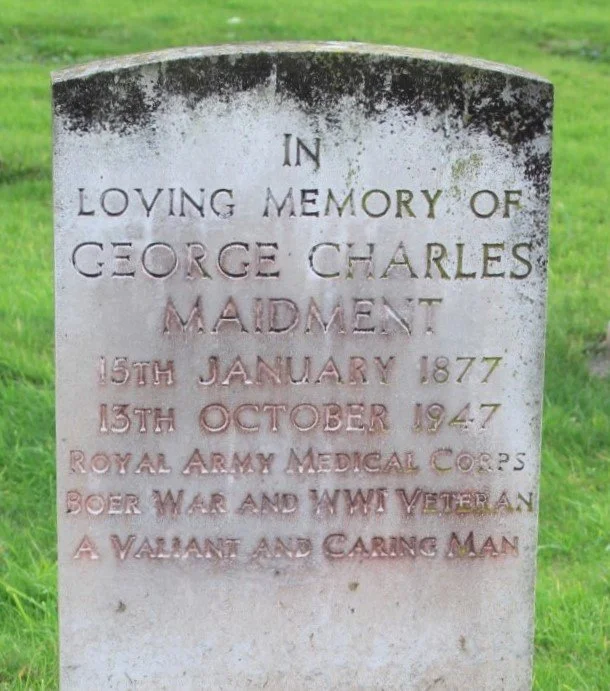George Charles Maidment
///adopt.occurs.mice
George Charles Maidment was born on the 15th January 1877, in Kentish Town, just North of St Pancras in London. He grew up in the area and in the 1891 census was a grocers assistant living with his family near Hanover Square.
In January 1897 he joined the Royal Army Medical Corps (RAMC) as an orderly and two years later found himself at war for the first time.
On the 9th October 1899, the Boers gave the British an ultimatum that they withdraw their troops from the borders of the South African Republics. The British refused and two days later the Anglo-Boer War commenced.
The mounted Boer Commandos swept into the British Colony of Natal and pushed back the British troops. Within a month they were on the outskirts of the town of Ladysmith, the last major obstacle facing the Boers before they reached the coast. The British troops, under the command of General Sir George White, were told that their duty was to stand firm in the town and to prevent it being taken. This was the start of the Siege of Ladysmith where 21,000 Boers encircled the town containing 12,000 British troops.
George Charles Maidment, was in the town and for more than 100 days he recorded the events of the siege in his diary in fascinating detail. This included the daily tedium, the fighting, the sniping, the lack of food and the disgust at having to eat their own horses. The siege of Ladysmith ended in February 1900 and the Boer war finally ended in May 1902.
After the war George was posted to the hospital for the Boer prisoners of war in Bermuda. Records show that he attended the local freemasons lodge there. He finally returned to England later in 1902. After his return, George settled down to barrack life and in 1904 he married Nancy Large, from Longford, who tragically died the following year while they were living in Orford Barracks in Warrington, Lancashire.
George was then posted to Normanton Barracks in Derby where he met and married Catherine Gertrude Florence Knutton. They went on to have 3 daughters. George left the army in 1909 after 12 years of service.
In 1911 he is recorded on the census as being a storekeeper living with his family in Harrington Street.
When World War 1 broke out in 1914. George rejoined the RAMC and was sent to Greece with the British Expeditionary Force. He was rescued twice from hospital ships that were sunk, first by a torpedo and then when the S.S. Anglia hit a mine. Before abandoning the Anglia, George went below to save the ship's cat and to retrieve "Jimmy", his ventriloquist's dummy. While there he found a Lt. Capper trapped, so he helped him to safety. Sadly "Jimmy" was not so fortunate and went down with the ship.
Jimmy was subsequently replaced by a new dummy, also called "Jimmy".
Throughout the war George and Jimmy entertained patients with their ventriloquist act and after the war they made a number of public appearances which were well received.
George survived the Great War but his wife had passed away in 1917 while he was still in Greece.
When he returned to Derby he went to live with the Luscombe family and secured work with Rolls Royce as one of their first medical officers. He regularly entertained the children of his fellow workers at the Rolls Royce annual Christmas party and he remained with the company until he retired.
In the 1939 register, George is recorded as living on Nightingale Road with the occupation of an Ambulance Attendant. He then lived through yet another war.
After a long period of ill health he died on 13 October 1947, at the age of 70, and was buried in Nottingham Road Cemetery. His family presented his diaries and medals to the RAMC museum in Aldershot in 1973. His diaries are now safe in the Wellcome Centre for Medical Science in Euston Road, London, as part of their RAMC archive. This is not far from his place of birth.
Alan Chalmers wrote a book based on Georges Ladysmith Siege diary and arranged with George's relatives to have a headstone placed in Nottingham Road Cemetery where the grave had remained unmarked. The headstone was unveiled using a Union Jack which the great grandmother of Alan Chalmers had waved when Ladysmith was relieved in 1900. The family pictures in this article are taken from the book with permission from the author.





